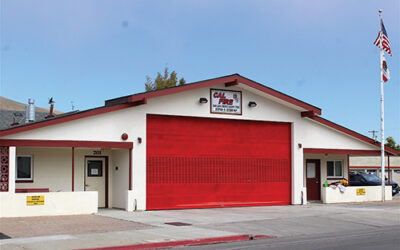The City of Morro Bay is for the first time ever using the Constitutional power of “eminent domain” in a lawsuit seeking to force the owners of the Morro Bay Power Plant to grant easements needed for the City’s Water Reclamation Facility (WRF) project.
The lawsuit, filed Feb. 26, 2020 by the City’s contracted law firm, Aleshire & Wynder, LLP, essentially seeks three permanent easements and two temporary easements needed during construction.
It seeks a linear easement from the Triangle Lot on the waterfront through the plant to connect with a new sewer main line that will run parallel to Hwy 1 behind the plant.
That so-called “West alignment” pipeline would bypass an existing sewer main that collects sewage from the Downtown, the Heights and the Embarcadero, sending it to the existing treatment plant on Atascadero Road.
That portion asks for a permanent easement consisting of some 0.85 acres (37,026 square feet) for the raw sewage pipeline.
The City also wants a temporary, 3-month construction easement for this pipeline project, some 2.14 acres (93,218 s.f.).
The suit seeks a permanent pipeline easement of 1.94 acres (84,506 s.f.) for another pipeline that will carry treated wastewater for reuse in an “Indirect Potable Reuse” or IPR system.
The injection well field and accompanying pipelines is another 3.82 acres (166,399 s.f.) and the City wants a permanent easement for this.
This portion would also need a temporary construction easement of 4.43 acres (192,971 s.f.) for up to 15 months, according to the suit.
The power plant property in question is pegged at 96 total acres.
It is believed that this marks the first time in its over 50-year history that the City has used eminent domain; a change in a long-standing policy of seeking “willing sellers” when it needs property for a public project.
The WRF project, at $130 million is by far the biggest public works project the City has ever undertaken.
Such cases involve an agency paying fair market value for the taking of private property, in this case in the form of easements.
The City hired real estate appraiser, Todd Murphy, an owner of the firm, Schenberger, Taylor, McCormick & Jecker of San Luis Obispo. His report looks at each easement individually and places a value on it.
“As part of my appraisal study,” Murphy wrote, “I personally conducted a physical inspection of the property described in the Complaint on file in this action.”
He goes on to say that he interviewed public officials and representative of Vistra. He reviewed the market data (land sales) “in the immediate and general subject market area, and a valuation analysis.”
Murphy pegs the easement values as: $37,026 for the sewer main easement; $3,263 for the temporary construction easement; $59,154 for the recycling pipeline easement; $33,770 for a temporary construction easement for the IPO system; and $66,560 for the injection well field, for a total of $200,000.
That’s what the City has offered in the lawsuit and a judge will decide if it’s a fair price.
The lawsuit claims that the City started negotiations with Vistra Energy (owners of the power plant) back in Spring 2019, City Manager Scot Collins testified in court filings.
“During the negotiations,” Collins said under oath, “owner [Vistra] requested that the City consider the approval of a
development project on the larger parcel in exchange for the easement interests. We were not able
to reach an agreement regarding the City’s acquisition of the easement interests.”
Vistra last year had proposed a “Battery Energy Storage System” or BESS, a giant battery storage facility at the plant to store energy generated by sources like wind and solar farms, for use when demand is high.
Vistra withdrew that project within just a few months of proposing it, and is pursuing BESS projects at its other California power plants.
“With battery energy storage developments underway in both Moss Landing and Oakland,” Meranda Cohn with Vistra said back in May, “Vistra would like to extend its battery capabilities at its retired power plant site in Morro Bay — and remains willing to do so. Unfortunately, we’ve reached a stalemate with the City of Morro Bay about the long-term ownership of the site impeding development of the property, which could contribute economic activity and tax revenues to the community.”
Some candidates for city council have pointed to the BESS project as a future economic booster for the City, even though currently Vistra does not have an active application with the City.
The BESS project coupled with a potential offshore wind energy farm that would bring its electricity ashore at the power plant for connection with the power grid could revive the power plant’s importance with the State’s energy system.
The plant hasn’t produced energy since it was closed by then owners, Dynegy Inc., (which merged with Vistra), in early 2014.
Estero Bay News tried to contact Cohn seeking a statement from Vistra on the lawsuit but she didn’t respond before deadline.
Collins, in his sworn statement claimed that, “Relocating the easement interests would adversely affect more private property not already dedicated to a public use, would adversely affect sensitive cultural resource areas, and would
significantly increase construction costs and risks.”
He testified that the WRF couldn’t be built and the City meet deadlines imposed by the Regional Water Quality Control Board to upgrade its sewage treatment, without these easements.
“Without the easement interests, water and effluents would not be able to be transported to and from the new WRF, the
pump stations, or wells, and there would be no injection wells to provide replenishment of
groundwater within the area. Without the easement interests, the [WRF] Project could not be constructed.”
Asked about this, considering that the existing pipeline now delivers sewage from roughly half the town to the Atascadero Road plant, and the City is planning a new lift station there to push sewage from the north end of town, this new pipeline would seem to not be necessary.
“The ‘Project,’” Collins replied, “as defined includes not only the WRF, but also the pipelines and appurtenances of the West alignment. All other alternative alignments for the pipelines and appurtenances were considered carefully by the City Council on numerous occasions, but ultimately rejected for cost and/or feasibility concerns, so those alignments are not part of the Project.
“Thus, the Project necessarily includes the pipelines and appurtenances of the West alignment, to the exclusion of all other alternative alignments. Accordingly, the easement interests where the pipelines and appurtenances will be located are necessary for the Project.”
Collins declined comment on the lawsuit but did infer that the City had gotten promising indications from the judge and was confident the City would prevail.


